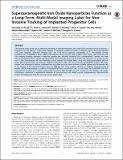| dc.contributor.author | Pacak, Christina A. | en_US |
| dc.contributor.author | Hammer, Peter E. | en_US |
| dc.contributor.author | MacKay, Allison A. | en_US |
| dc.contributor.author | Dowd, Rory P. | en_US |
| dc.contributor.author | Wang, Kai-Roy | en_US |
| dc.contributor.author | Masuzawa, Akihiro | en_US |
| dc.contributor.author | Sill, Bjoern | en_US |
| dc.contributor.author | McCully, James D. | en_US |
| dc.contributor.author | Cowan, Douglas B. | en_US |
| dc.date.accessioned | 2014-11-03T17:38:09Z | |
| dc.date.issued | 2014 | en_US |
| dc.identifier.citation | Pacak, Christina A., Peter E. Hammer, Allison A. MacKay, Rory P. Dowd, Kai-Roy Wang, Akihiro Masuzawa, Bjoern Sill, James D. McCully, and Douglas B. Cowan. 2014. “Superparamagnetic Iron Oxide Nanoparticles Function as a Long-Term, Multi-Modal Imaging Label for Non-Invasive Tracking of Implanted Progenitor Cells.” PLoS ONE 9 (9): e108695. doi:10.1371/journal.pone.0108695. http://dx.doi.org/10.1371/journal.pone.0108695. | en |
| dc.identifier.issn | 1932-6203 | en |
| dc.identifier.uri | http://nrs.harvard.edu/urn-3:HUL.InstRepos:13347408 | |
| dc.description.abstract | The purpose of this study was to determine the ability of superparamagnetic iron oxide (SPIO) nanoparticles to function as a long-term tracking label for multi-modal imaging of implanted engineered tissues containing muscle-derived progenitor cells using magnetic resonance imaging (MRI) and X-ray micro-computed tomography (μCT). SPIO-labeled primary myoblasts were embedded in fibrin sealant and imaged to obtain intensity data by MRI or radio-opacity information by μCT. Each imaging modality displayed a detection gradient that matched increasing SPIO concentrations. Labeled cells were then incorporated in fibrin sealant, injected into the atrioventricular groove of rat hearts, and imaged in vivo and ex vivo for up to 1 year. Transplanted cells were identified in intact animals and isolated hearts using both imaging modalities. MRI was better able to detect minuscule amounts of SPIO nanoparticles, while μCT more precisely identified the location of heavily-labeled cells. Histological analyses confirmed that iron oxide particles were confined to viable, skeletal muscle-derived cells in the implant at the expected location based on MRI and μCT. These analyses showed no evidence of phagocytosis of labeled cells by macrophages or release of nanoparticles from transplanted cells. In conclusion, we established that SPIO nanoparticles function as a sensitive and specific long-term label for MRI and μCT, respectively. Our findings will enable investigators interested in regenerative therapies to non-invasively and serially acquire complementary, high-resolution images of transplanted cells for one year using a single label. | en |
| dc.language.iso | en_US | en |
| dc.publisher | Public Library of Science | en |
| dc.relation.isversionof | doi:10.1371/journal.pone.0108695 | en |
| dc.relation.hasversion | http://www.ncbi.nlm.nih.gov/pmc/articles/PMC4177390/pdf/ | en |
| dash.license | LAA | en_US |
| dc.subject | Biology and Life Sciences | en |
| dc.subject | Anatomy | en |
| dc.subject | Biological Tissue | en |
| dc.subject | Muscle Tissue | en |
| dc.subject | Muscle Cells | en |
| dc.subject | Biotechnology | en |
| dc.subject | Bioengineering | en |
| dc.subject | Tissue Engineering | en |
| dc.subject | Cell Biology | en |
| dc.subject | Cellular Types | en |
| dc.subject | Animal Cells | en |
| dc.subject | Precursor Cells | en |
| dc.subject | Stem Cells | en |
| dc.subject | Engineering and Technology | en |
| dc.subject | Medicine and Health Sciences | en |
| dc.subject | Cardiology | en |
| dc.subject | Cardiovascular Imaging | en |
| dc.title | Superparamagnetic Iron Oxide Nanoparticles Function as a Long-Term, Multi-Modal Imaging Label for Non-Invasive Tracking of Implanted Progenitor Cells | en |
| dc.type | Journal Article | en_US |
| dc.description.version | Version of Record | en |
| dc.relation.journal | PLoS ONE | en |
| dash.depositing.author | Hammer, Peter E. | en_US |
| dc.date.available | 2014-11-03T17:38:09Z | |
| dc.identifier.doi | 10.1371/journal.pone.0108695 | * |
| dash.contributor.affiliated | McCully, James | |
| dash.contributor.affiliated | Hammer, Peter | |
| dash.contributor.affiliated | Cowan, Douglas | |


